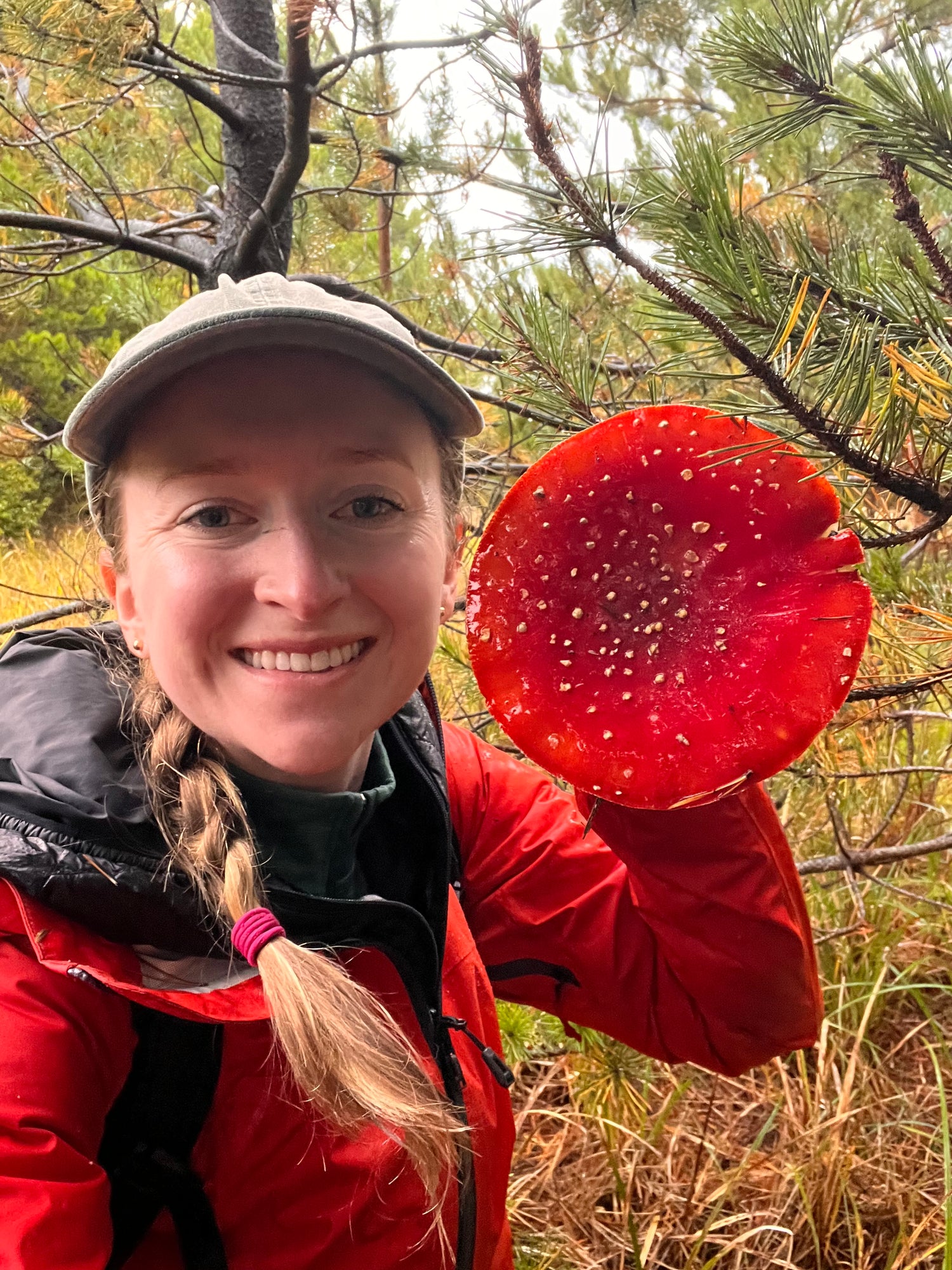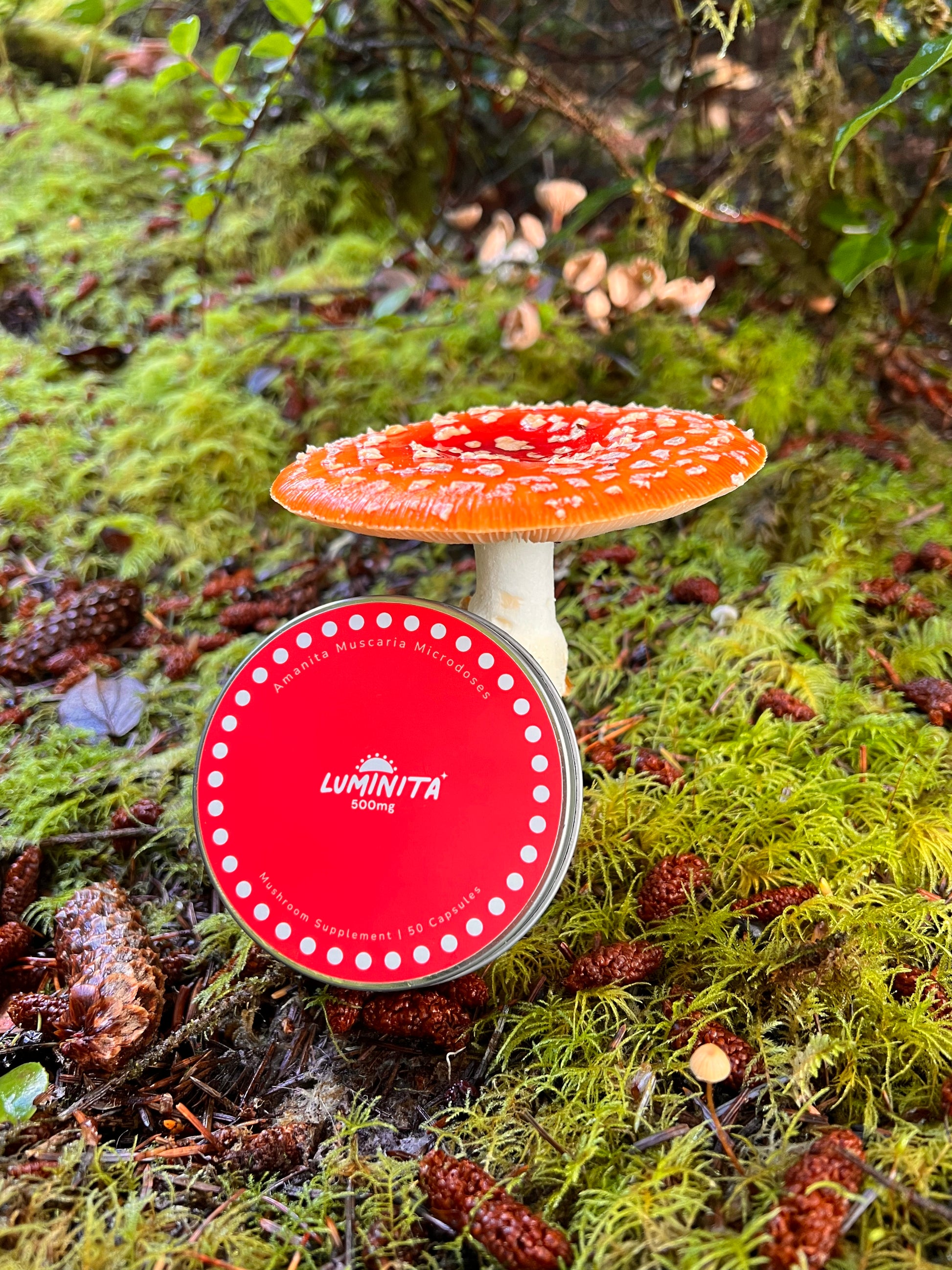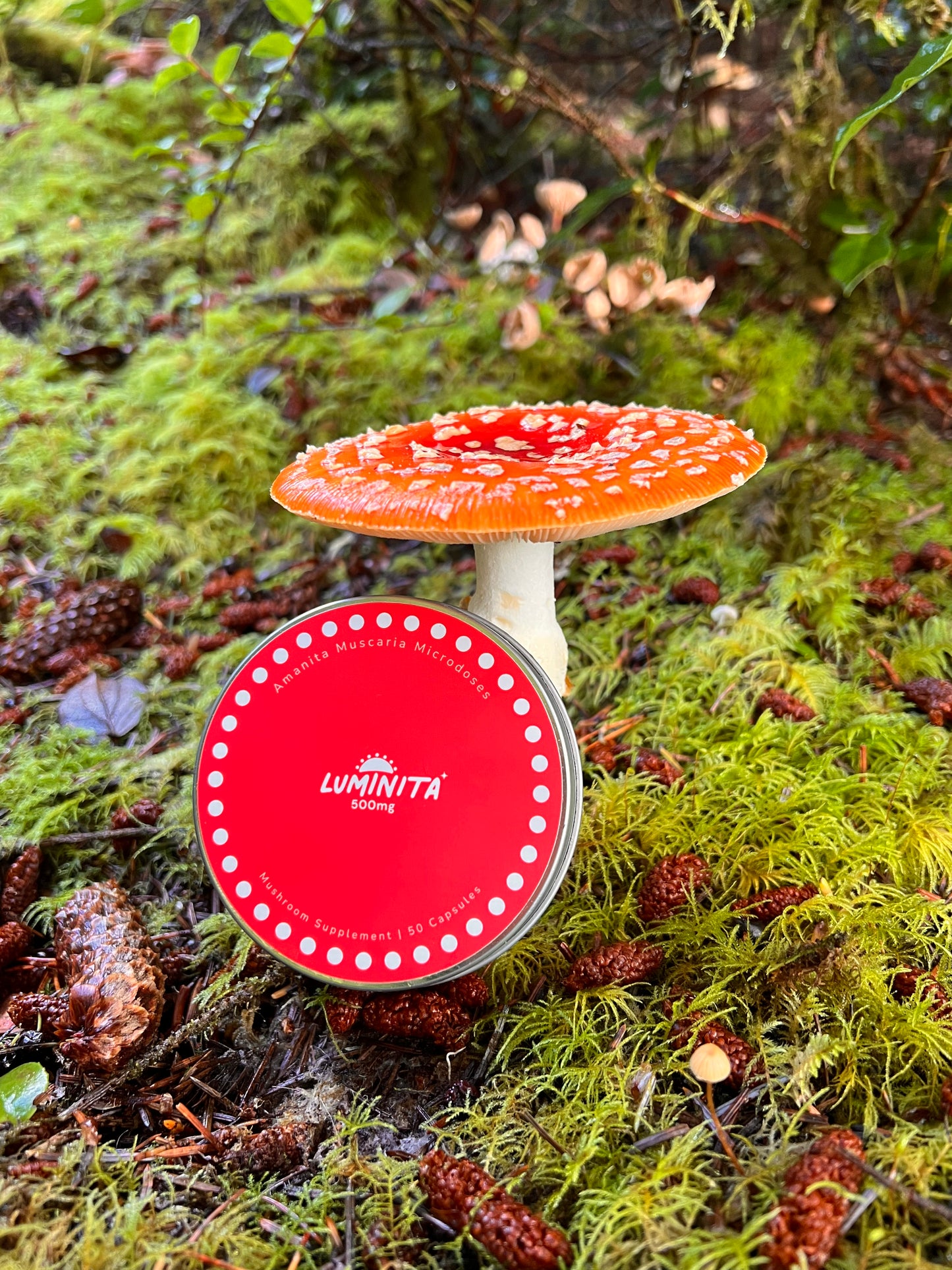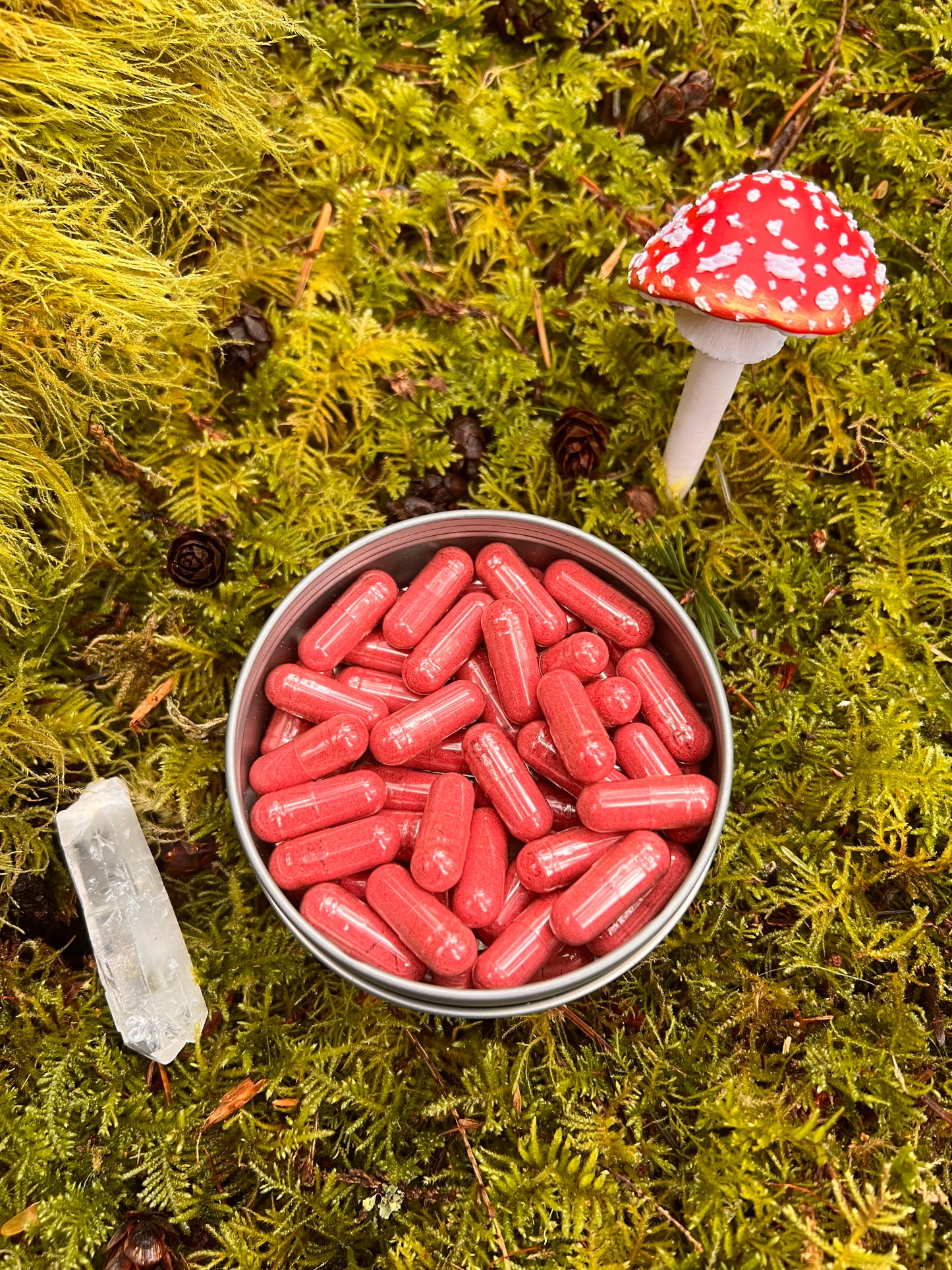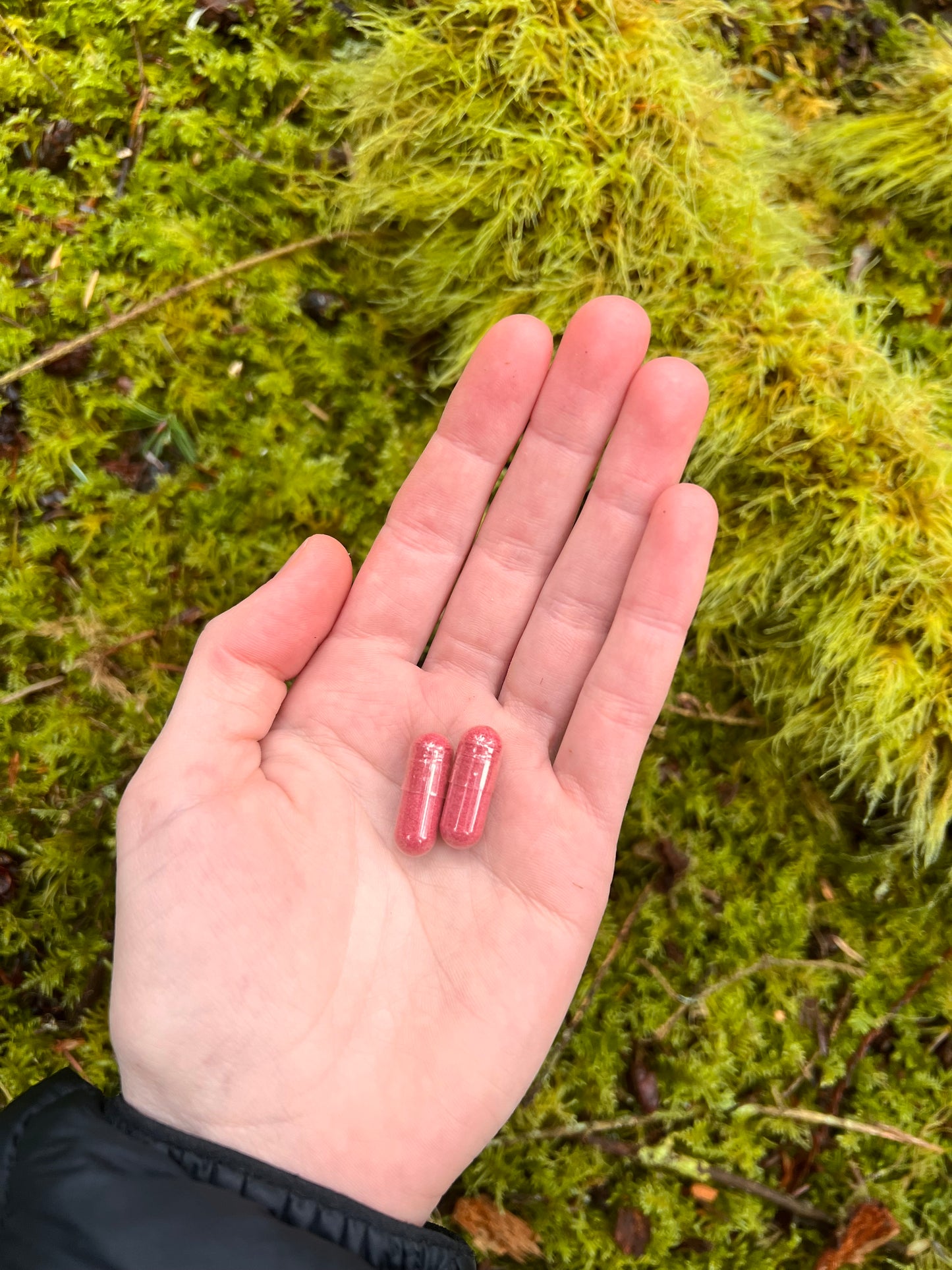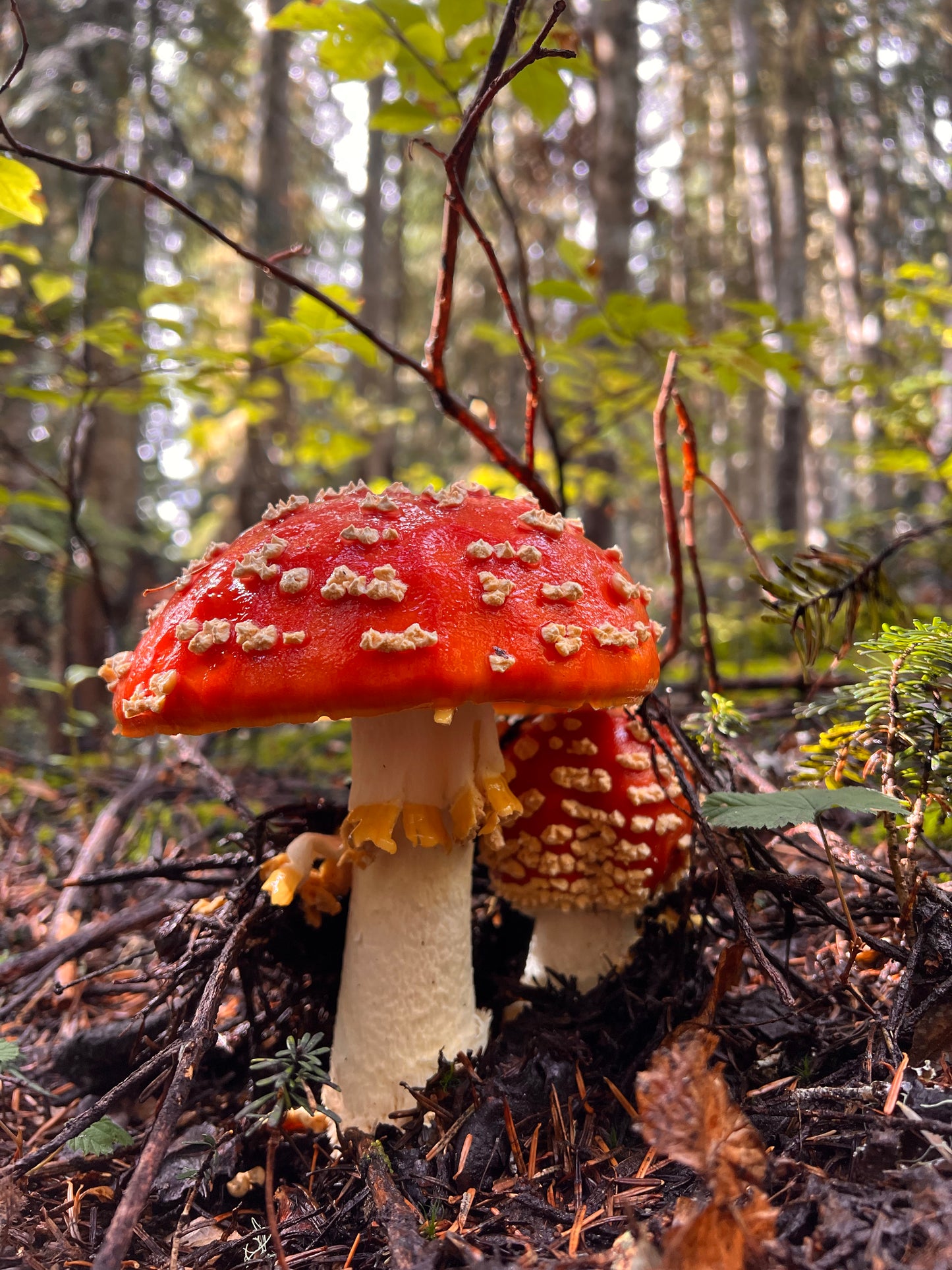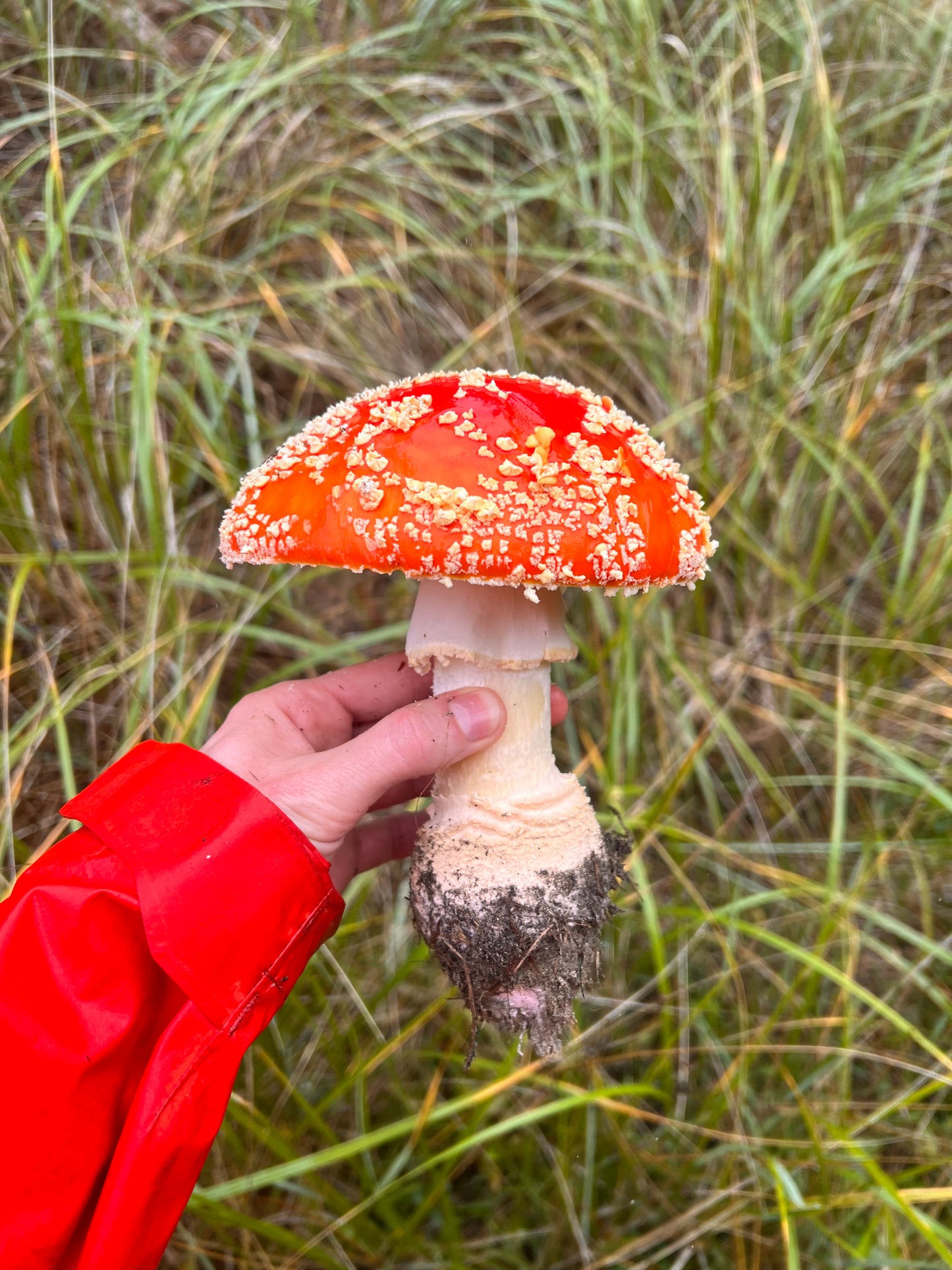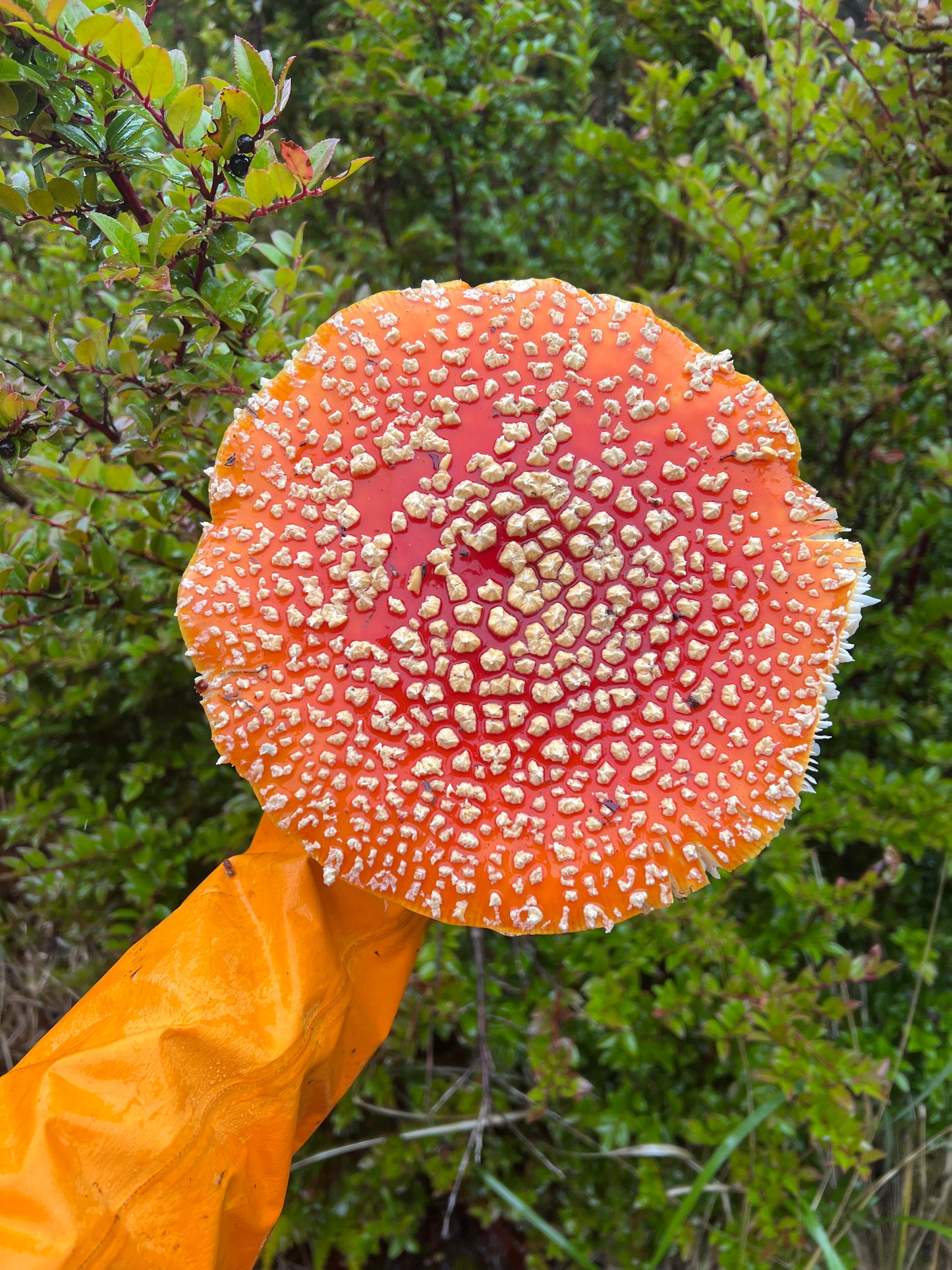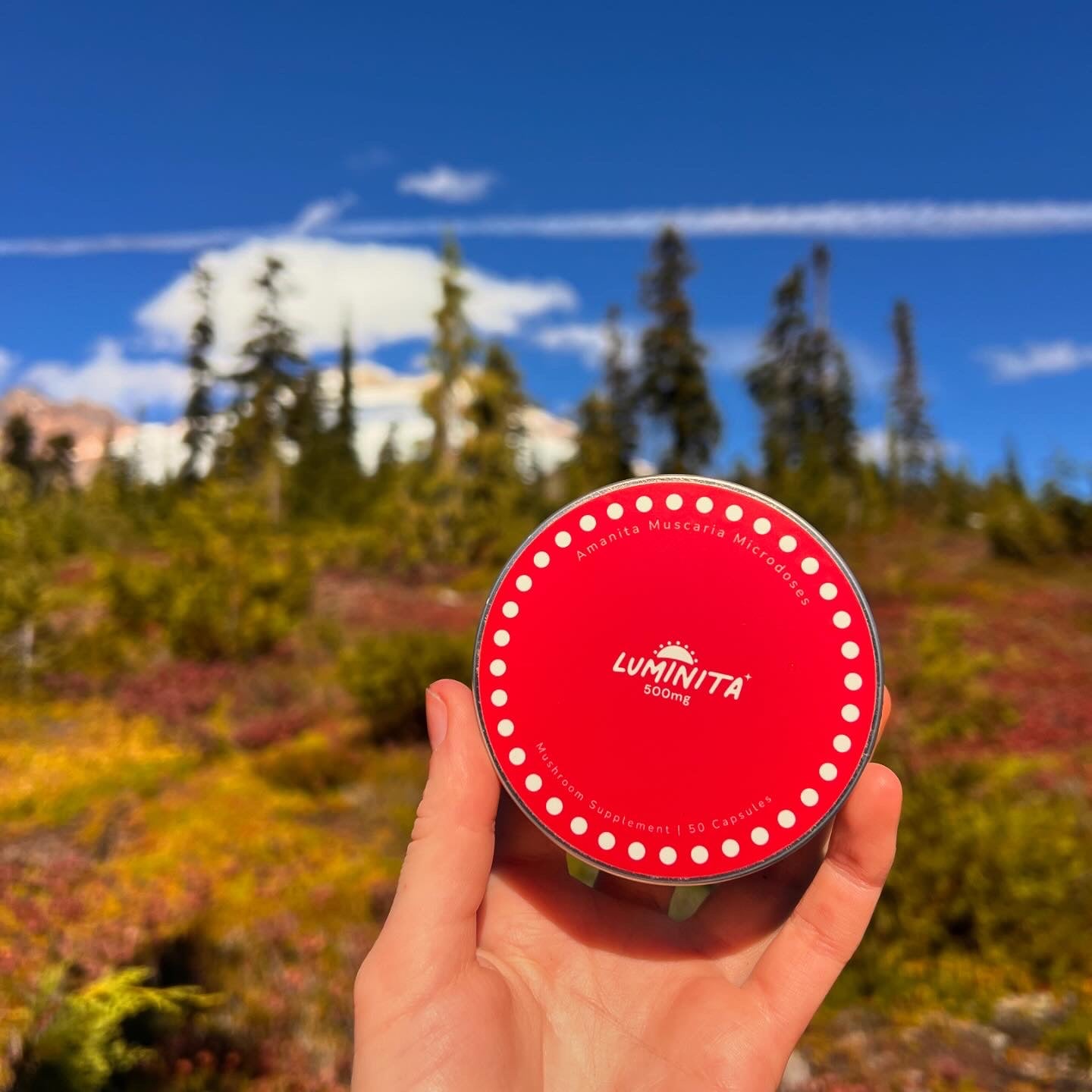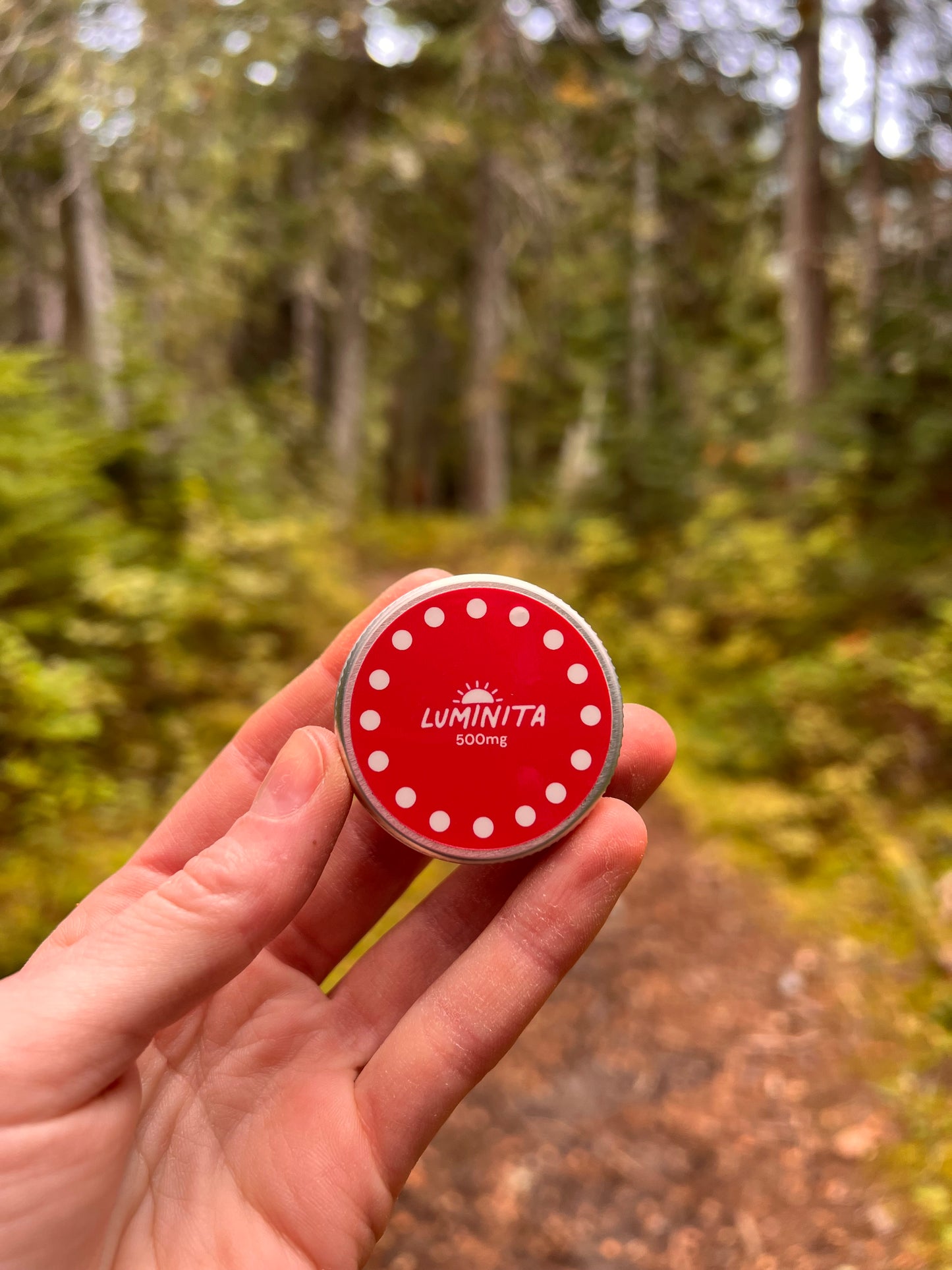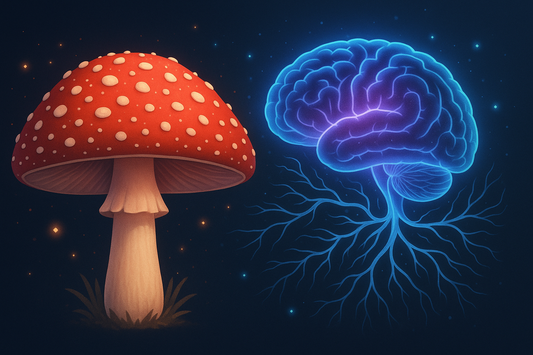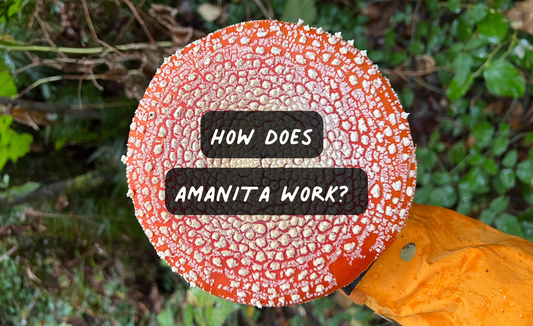Journal Contents:
- Intro
- Main Psychoactive Alkaloids
- Muscimol
- Ibotenic Acid
- Other Nitrogen Containing Components
- Pigments
- Enzymes
- Lipids
- Phosphorous Substances
- Vitamins & Derivatives
- Polysaccharides
- Phenolic Compounds
- Sugars
- Minerals
- Amino Acids
- Metals
- Other
If you have found this page, congrats! You are in the top 1% of people, who care deeply about what they are consuming and putting into their body. This is especially important when we are talking about wild foraged mushrooms, and even more so with Amanita muscaria.
Knowing what gives it healing properties, what causes negative side effects, and what causes the differences between mushrooms will go a long way in helping you have the most positive experience with this fungus.
Most people are aware of Amanita muscaria’s psychoactive properties. This is mostly due to the presence of ibotenic acid and muscimol, which are the two main compounds found in the mushroom. However, Amanita mushrooms also contain a complex blend of hundreds of other biologically active compounds. These alkaloids, peptides, vitamins, minerals, pigments, polysaccharides and amino acids work together synergistically to give the mushroom its healing capabilities.
Some of these molecules are well studied and are known to have medicinal properties, some have toxic properties and must be processed to render them safe to consume and others are novel and have only been found within Amanita mushrooms.
Combined, these molecules help give Amanita muscaria neuroprotective, cardio protective, hepatoprotective, anti-inflammatory, antioxidant, antibacterial, antifungal, antiviral, glucose-regulating as well as antitumor potential. This may sound surprising at first, but anyone who has microdosed with Amanita mushrooms long enough can attest to its healing potential. They help you feel strong, healthy and more in tune with your body.
Please note, this list encompasses mushrooms that were analyzed by different research groups from all around the world. Not every mushroom you find or consume will contain all of these chemicals, but they will contain most.
Use this article as a general guide to what is currently known about the chemical makeup of Amanita muscaria. We are only at the beginning of fully understanding the complexity and wonder that make up this mushroom. With time, much more will be unveiled.
With that being said, let’s dive into specifics.
Main Psychoactive Alkaloids:
Scientists have identified two main psychoactive chemicals in the Amanita muscaria mushrooms. These are:
1. Muscimol: This is the primary psychoactive chemical found in Amanita muscaria. It is responsible for what most would consider the characteristic effects of the mushroom. Some general facts about muscimol:
- Muscimol is found in low amounts in the raw mushroom. When dried and prepared into a tea, the ibotenic acid converts to muscimol.
- Muscimol is an agonist of GABAa and GABAc receptors (meaning it activates these receptors in the brain).
- GABA is the most common inhibitory neurotransmitter (or chemical messenger). It helps slow down the brain by blocking the signals of overactive neurons. GABA is thought to be responsible for calming nerve cell hyperactivity that is caused by anxiety, stress and fear. (1)
- Decreased GABA activity has been found to cause problems such as: anxiety, mood disorders, schizophrenia, autism symptoms, depression, epilepsy. (1)
- Muscimol blocks the uptake of GABA, resulting in increased serotonin and acetylcholine levels, and lowered catecholamines (norepinephrine & epinephrine.)
- Тhe activation of the GABAA receptor by muscimol modulates the hypothalamic–pituitary–gonadal (HPG) axis (Kanasaki et al. 2017). The HPG axis is responsible for regulating reproductive hormones, suggesting muscimol may help regulate and balance hormones.
- Muscimol’s effects are consistent with its role as a GABAa agonist. Studies on muscimol show promise for a range of conditions.
- Improving memory: Intra-hippocampal infusion of muscimol significantly increased the percent of neurons active, improving rats’ learning and memory abilities. This suggests that increasing GABAergic processes may be an useful strategy in early memory decline in in Alzheimer's disease (Pilipenko et al. 2015)
- Reducing Inflammation: Polymers (Fucomannogalactan and glucan) obtained from Amanita muscaria presented potent inhibition of inflammatory pain. (Ruthes et al. 2013)
- Improving Sleep: Muscimol helps decrease wakefulness, promote slow wave sleep, and also increases the number and duration of REM episodes. Additionally, muscimol increases the ability for the brain to form sleep spindles, which facilitate long term memory storage and neuroplasticity. (27)
- Neuroprotective Properties: Muscimol possesses statistically significant neuroprotective properties in rat models (30)
- Reducing Stress: Muscimol helps quiet an overactive mind by increasing the amount of GABA, the inhibitory neurotransmmiter, in the brain. Additionally, it has been shown to reduce conditioned fear-responses (long term anxieties) in rat studies. (31)
2. Ibotenic Acid: Neurotoxin Contributes to most of the unpleasant side effects of Amanita muscaria. Ibotenic acid, unlike muscimol, is much more dangerous, causing ibotenate-induced seizures and lesions in specific brain regions,
- Agonist of NMDA glutamate receptors.
- Precursor to muscimol.
- Can pass through the blood brain barrier.
- Is partially metabolized in the stomach, liver, and brain.
- Administration of ibotenic acid (5µg/µl) into the hippocampal area of the brain in rats impairs cholinergic transmission, learning and memory performance similar to Alzheimer’s disease and thus ibotenic acid is often used to induce alzheimer’s like symptoms in rats to test novel drugs that may help cure the disease. (Stebelska 2013)
- Ibotenic acid increases catacholamines (norepinephrine and epinephrine).
- Ibotenic acid readily decarboxylates into muscimol when exposed to heat and acid.
Other “Nitrogen” containing Components:
-
Muscarine: Muscarine was originally thought to be the main active substance in Amanita muscaria for decades, until muscimol and ibotenic acid were discovered. In reality, muscarine is present in super low levels in Amania, (0.0002-0.0003%) and it was observed that muscarine “was inactive by mouth in monkeys in a quantity many times that which would cause poisoning by ingestion of Amanita muscaria in the human.” Muscarine is a muscarinic cholinergic agonist which means it activates the parasympathetic nervous system (or the parts of the body responsible for resting and digesting). Negative side effects of muscarine only present themselves in excessively large amounts and include: sweating, salivation, lacrimation, and other parasympathetic effects, reduced heart rate, lowering of blood pressure, vomiting, diarrhea, bradycardia, bronchorrhea, tearing, bronchospasm (asthmatic-like breathing), salivation, pupil contraction and blurred vision. To avoid any of these symptoms, amanita muscaria should only be consumed in small to medium doses.
-
Muscazone: Produced when ibotenic acid is broken down by UV radiation. Compared to ibotenic acid and muscimol, muscazone produces weak pharmacological effects. (25)
-
Muscaridine: It is an acyclic isomer of muscarine and belongs to a group of stimulant substances.
-
R-4-hydroxypyrolidin-2-one: Similar structure to muscimol and ibotenic acid. It demonstrates some antibacterial and antifungal properties.
-
Hercynine: an amino acid precursor to L-ergothioneine.(L-ergothioneine has antioxidant properties)
-
Stizolobic acid, Stizolobinic acid & tricholomic acid: Derivatives of ibotenic acid. Small amounts have been found in Amanita mushrooms. Studies show they have mild stimulating effects.
-
1,2,3,4-tetrahydro-1-methyl-B-carboline-3-carboxylic acid: Substance of unknown pharmacology
-
B-indoleacetic acid: An important plant hormone.
-
Scopolamine: Found in small quantities in some amanita mushrooms. It is an alkaloid that inhibits the muscarinic acetylcholine receptors in the central nervous system. By reducing the effects of the parasympathetic system, it can increase heart rate and pupil size. As a drug, it is approved for use as a preventative for nausea and vomiting.
-
Atropine: Found in small amounts in Amanita mushrooms. Has similar properties to scopolamine. Used as an antidote for muscarinic poisoning. As a drug, atropine has been used to increase pupil size and increase heart rate.
-
Betalamic Acid: Constituent of betalain pigments. A potent scavenger of free radicals. (13)
Piments:
Amanita mushroom caps range in color from a pale yellow to a deep scarlet red. The color often varies due to location, age and sun fading. Originally it was thought that ibotenic acid was responsible for its color, but isolated ibotenic acid is in fact a clear crystalline solid. Deeper investigations into the coloring of Amanita find it is due to a complicated mixture of chemicals. Below are some of the main ones discovered.
- Beta-carotene: yellow pigment
- Muscarufins: yellow pigment
- Muscaflavin: yellow-orange pigment
- Betaxanthins: yellow-orange pigment
- Carotenoids: orange pigment
- Musca-aurins: orange pigment, also found in beets
- Stizolobic acid: red-orange pigment
- Muscarubrin: red pigment
- Violet-muskapurpurine: red-violet pigment
- Red-brown muscarubin: red brown pigment
- Amavadin: light blue pigment. Contains the heavy metal vanadium. Researchers hypothesize that amavadin may help the mushroom self-regenerate damaged tissues.
Enzymes:
Enzymes in mycorrhizal mushrooms are often used to catalyze reactions in the organism or facilitate binding of mycorrhizal tendrils to root tips.
- DOPA 4,5-dioxygenase: key enzyme of betalain biosynthesis
- Aspartic protease: perform functions related to nutrition and pathogenesis
- 4-aminobutyrate (GABA-T): its role is to transfer nitrogenous groups from one molecule to another. In fungi, it helps produce succinate semialdehyde and L-glutamate.
- 6-hydroxynicotinate: catalyzes the decarboxylative hydroxylation of 6-hydroxynicotinic acid (6-HNA) to 2,5-dihydroxypyridine (2,5-DHP)
Lipids:
Lipids are fatty molecules that perform a variety of functions in both mushroom and human bodies. They help with moving and storing energy, absorbing vitamins, making hormones and are the major building block of cell membranes.
- Linoleic acid
- Oleic acid
- Stearic acid
- Palmitic acid
- Hydroxy fatty acids: very low amounts
- 1,3-diolein diacylglycerol: house fly attractant
- Sphingolipids (Ceramides & Cerebrosides): May help with growth regulation, cell migration, adhesion, apoptosis, aging and inflammatory reaction
- Phospholipids
Phosphorous Substances:
- Monoesters
- Diesters
- Pyrophosphates
- Polyphosphates
- Phoshphonates
Vitamins & Derivatives:
Although not typically looked at as a vitamin rich mushroom, Amanita muscaria mushrooms contain a range of vitamins that help heal and restore the health of our bodies.
-
Ascorbic acid (Vitamin C): Vitamin C helps the body make collagen, an important protein used to make skin, cartilage, tendons, ligaments, and blood vessels. Vitamin C is needed for healing wounds, and for repairing and maintaining bones and teeth. (28)
-
Tocopherols (Vitamin E). Used as an antioxidant in mushrooms. As a supplement, vitamin E helps prevent blood clots & boost immune system function. (23)
-
Carotenoids (Vitamin A): Can be converted into Vitamin A in the body. Has anti-inflammatory properties. (24)
-
Biotin: Protects the mushroom from parasites and predators while growing. In humans, biotin helps us break down food into energy. (21)
-
Niacin (Vitamin B3): As a supplement niacin is used to reduce inflammation and improve blood circulation. (22)
-
Hyoscyamine: an alkaloid that is a natural antimuscarinic. It inhibits the parasympathetic nervous system which activates the salivary, bronchial and sweat glands as well as the eye, bladder, heart and gastrointestinal tract. In the clinical setting, it is used to relieve spasms in people with peptic ulcers, irritable bowel syndrome, colic, diverticulitis and pancreatitis.
-
Ergosterol: Effective as antiviral, antibacterial, anti-inflammatory, anti-diabetic, neuroprotective and anti-cancer. (3) Anti-cancer effect of ergosterol is associated with the inhibition of angiogenesis caused by a growing tumor. Amanita fruiting bodies contain large amounts of ergosterol - up to 77mg/g of dry mass. (4). Compare that to button mushrooms which contain 7.8mg/g (5)
Polysaccharides:
Disaccharides and polysaccharides are especially good carbon sources for the production of mushroom fruiting bodies.
-
Flucomannogalactan: Has anti-inflammatory and antinociceptive properties.
-
(1-3),(1-6) linked beta-delta-glucan: Polymers of glucose that help give structure to the fungal cell wall. When ingested, it shows significant antitumor activity against sarcoma tumors in mice. (29)
Phenolic Compounds:
- Flavonoids
- Lignans
- Oxidized polyphenols
- Phenolic acids
- Stilbenes
- Tannins
Sugars:
- A & B - Glucose
- Fructose
- Galactose
- Sorbitol
- Trehalose:
- UDP-carbohydrate
- Glycerol
- Mannitol: Helps protect Amanita mushrooms from water and thermal stress. Mannitol also improves the delivery of drugs to the brain by opening the blood brain barrier (the blood brain barrier is a highly selective layer of cells that protect the brain from the rest of the body) “This inspired the hypothesis that the relatively high concentrations of mannitol in fly agaric enables more efficient transportation of ibotenic acid and muscimol into the brain and thus enhances their hallucinogenic activity”. It may explain why consumption of amanita muscaria mushrooms produce greater effects than an equal amount of isolated ibotenic acid and muscimol. (3)
Minerals:
- Potassium
- Phosphorus
- Calcium
- Thiamine
- Riboflavin
- Pyridoxine
- pantothenic acid
- Nicotinic acid
- Nicotinamide
- Folic acid
- Cobalamin
- Zinc
- Selenium
Amino Acids:
Amino acids are molecules that are used by all organisms to build proteins. Mushrooms are especially rich in amino acids and protein, and Amanita is no different. Particularly interesting is the inclusion of NAC, a well studied molecule that is often sold as an over the counter supplement.
- Tyrosine
- Phenylalanine
- Leucine
- Valine
- Isoleucine
- Alanine
- Aspartate
- Asparagine
- Glutamic acid
- Aspartic acid
- Threonine
- L-3 4-dihydroxyphenylalanine (L-DOPA): precursor to dopamine and betalain pigments. Able to cross the blood-brain barrier and increase the levels of dopamine in the brain. Therapeutically it is used for the treatment of Parkinsons.
- N-acetylated compounds (NAC): NAC stimulates glutathione biosynthesis, promotes detoxification, and acts directly as a scavenger of free radicals. Glutathione is a powerful antioxidant and can help improve brain health, stabilize blood sugar levels and improve immune function.22
Metals:
Amanita muscaria mushrooms get their nutrition through a process called absorbotrophy or by using its mycelium to absorb nutrients from their surrounding environment. This means the fly agaric is able to absorb and bioaccumulate potential metals from the soil.
On one hand, this can make Amanita useful as a bioindicator of soil contamination. On the other hand this can be harmful for people wanting to consume Amanita to improve their health. This feature makes it especially important to make sure you are only ingesting Amanita mushrooms from clean environments. Avoid mushrooms collected near industrial waste sites, sewage irrigation, and areas adjoining previous or current mines.
Some of the metals that have been identified in samples of Amanita muscaria include (note that not all of these metals are found in every mushroom, and are highly variable depending on where the mushrooms were harvested:
- Vanadium (V)
- Mercury (Hg)
- Cadmium (Cd)
- Potassium (K)
- Rubidium (Rb)
- Arsenobetaine
- Arsenocholine
- tetramethyl-arsenic salt
- Cacodylic acid
Other:
- Choline
- Glycerophosphocholine
- Acetylcholine: very small amounts
- Betaine: very small amounts
- "Muscaridine": very small amounts
- Butenyl-trimethyl ammonium salt: very small amounts
- Hercynine: very small amounts
- (-)-R-4-hydroxypyrrolidone-(2)
- Uracil
- Hypoxanthine
- Xanthine
- Adenosine
- Carboline derivative XX
- Beta-D-N-butylglyco-pyranoside (XXI)
- Succinate
- Gluconate
- Malate
- Formate
- Fumarate
- Acetate
- Adenosine
- Uridine
- Quinolinate
- Isocysteine Sulfoxide
- Glutathione
- Ergothioneine
References:
(1)https://my.clevelandclinic.org/health/articles/22857-gamma-aminobutyric-acid-gaba
(2)https://pharmacia.pensoft.net/article/56112/
(3)https://www.mdpi.com/2304-8158/12/13/2529
(4) Fly Agaric: A Comprndium of History, Pharmacology, Mycology and Exploration. By Kevin Feeney. book.
(7)https://www.mdpi.com/2673-8392/1/3/69
(8)https://www.news-medical.net/life-sciences/What-are-Lipids.aspx
(10) Novaes MRCG, Valadares F, Reis MC, GonçalvesDR, Menezes MC (2011) The effects of dietary supplementation with Agaricales mushrooms and other medicinal fungi on breast cancer: Evidence-based medicine. Clinics 66: 2133- 2139.
(11)https://pubmed.ncbi.nlm.nih.gov/23932733/
(12)https://pubs.rsc.org/en/Content/ArticleLanding/1959/JR/JR9590003250
(13)https://www.sciencedirect.com/topics/chemistry/betalamic-acid
(14)https://journals.sagepub.com/doi/10.1016/j.wem.2022.06.002?icid=int.sj-full-text.similar-articles.1
(15)https://pubchem.ncbi.nlm.nih.gov/compound/Hyoscyamine
(16)https://pubmed.ncbi.nlm.nih.gov/12559386/
(17)https://www.sciencedirect.com/science/article/abs/pii/S0379073806000090
(18)https://go.drugbank.com/drugs/DB00747
(19)https://www.ncbi.nlm.nih.gov/pmc/articles/PMC3956731/
(22)https://www.mountsinai.org/health-library/supplement/vitamin-b3-niacin
(24)https://lpi.oregonstate.edu/mic/dietary-factors/phytochemicals/carotenoids
(26)https://www.unodc.org/unodc/en/data-and-analysis/bulletin/bulletin_1970-01-01_4_page005.html
(27)https://www.ncbi.nlm.nih.gov/pmc/articles/PMC3621793/
(30)https://www.sciencedirect.com/science/article/abs/pii/S0278691519304764


